
| 
|


Friends Newsletter No. 57
March 2014
Friends are the guardians of Malvern's water heritage (Malvern Gazette 1 March 2013 p.14). We are an independent voluntary group who relentlessly promote research, conservation and celebration of the Springs, Spouts, Fountains and Holy Wells of the Malvern Hills and of Great Malvern as a Spa Town.
The Mulberry Tree Returns to Malvern
After years of endeavour we are delighted to report that the George Bernard Shaw Mulberry Tree has returned to Priory Park. Several saplings reared from the tree in Melbourne, Australia have now been lodged with Malvern Hills District Council Parks Department and planted on a cold winter's day in discreet locations to enable them to prosper and grow in the forthcoming years. The strongest will be selected for a commemorative plaque and formal unveiling in due course. In the picture one sapling has been planted near the Priory Park Spring a few yards from the site of Shaw's original tree which was blown down in the gales of November 2000. This project has been underway with Friends since 2007 and is now at last coming to fruition, thanks to the support of the many people and organisations who have participated. Coca-Cola made the whole scheme viable and it is now down to Ron Evans and team from the Council to take it to its next stage. For more details see www.Malvernspringsandwells.com (go to site 106).
Fencing off the Malvern Hills
We learn from the Malvern Observer (22/1/14) that the Malvern Hills Conservators intend to make Gullett Quarry less accessible to the public. This is in response to the deaths last summer that we reported in earlier Friends' newsletters and a report by the Royal Society for the Prevention of Accidents. To do this they will construct a 1.1 metre fence along the quarry's open edges. The Conservators have a fine line to draw between freedoms of access, albeit including those who choose to tombstone into the cold water from a great height and attempting to enforce individuals' behaviour by making a location supposedly and hopefully super safe. Here, as a Friend points out, is the dilemma. If you continually seek to make the environment a safer place, individuals become oblivious to the possible dangers. Young people consider themselves invulnerable because they have been protected from danger since birth. The more the protection, the greater the risk they unwittingly take, whether it be driving 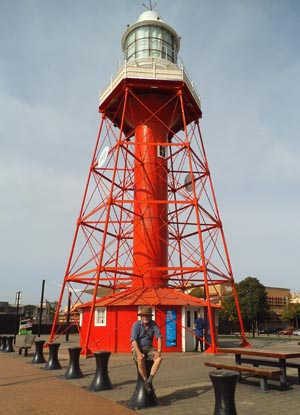 a fast car, consuming alcohol and cigarettes or diving into a quarry lake. Let's hope the fence makes a difference. But is there an alternative? Educating young people to the dangers that exist will likely be more effective. This helps to avoid the alternative which is, tragically, some learning the hard way. Education must be a far better route than leaving it to a disaster to imprint the dangers in the minds of the public.
a fast car, consuming alcohol and cigarettes or diving into a quarry lake. Let's hope the fence makes a difference. But is there an alternative? Educating young people to the dangers that exist will likely be more effective. This helps to avoid the alternative which is, tragically, some learning the hard way. Education must be a far better route than leaving it to a disaster to imprint the dangers in the minds of the public.
 a fast car, consuming alcohol and cigarettes or diving into a quarry lake. Let's hope the fence makes a difference. But is there an alternative? Educating young people to the dangers that exist will likely be more effective. This helps to avoid the alternative which is, tragically, some learning the hard way. Education must be a far better route than leaving it to a disaster to imprint the dangers in the minds of the public.
a fast car, consuming alcohol and cigarettes or diving into a quarry lake. Let's hope the fence makes a difference. But is there an alternative? Educating young people to the dangers that exist will likely be more effective. This helps to avoid the alternative which is, tragically, some learning the hard way. Education must be a far better route than leaving it to a disaster to imprint the dangers in the minds of the public.The Malvern Springs and Wells Connection
What on earth does this picture of a preserved lighthouse in Port Adelaide, Australia, have to do with Malvern Springs and Wells you may ask? The story is convoluted but very interesting. The lighthouse was first lit in 1869 and originally stood at the entrance to the Port River near Adelaide. It was prefabricated in England of iron plates and shipped in pieces. It replaced the lightship Fitzjames which had been moored at the mouth of the Port River to mark the entrance to the harbour. The lighthouse was dismantled and relocated in 1901. The lantern was installed in a lighthouse on Wonga Shoal, which is off Semaphore Jetty. The iron structure was re-erected on South Neptune Island with a new lantern and served there until 1985. The lighthouse and lantern were then reunited; they were restored and re-assembled on its current site in Port Adelaide in1986. Inspection of the structure reveals that the lighthouse was made in Birmingham by Chance Brothers and Co. who specialised in glass and lighting. They were also the company that supplied the glass for the Great Exhibition in Hyde Park, 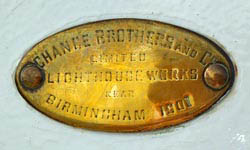 London in 1851. In all they supplied over 19,000 hand made panes of glass. The Great Exhibition centre piece was the Schweppes Crystal Fountain that we featured in our earleir Newsletter No. 55. It was at the Great Exhibition that bottled Malvern Water was launched by Schweppes; hence the connection with the vintage Adelaide lighthouse. Since then, like the lighthouse, the company of Chance has undergone various metamorphisms and, would you believe it, is now located in Great Malvern next to the Morgan car factory.
London in 1851. In all they supplied over 19,000 hand made panes of glass. The Great Exhibition centre piece was the Schweppes Crystal Fountain that we featured in our earleir Newsletter No. 55. It was at the Great Exhibition that bottled Malvern Water was launched by Schweppes; hence the connection with the vintage Adelaide lighthouse. Since then, like the lighthouse, the company of Chance has undergone various metamorphisms and, would you believe it, is now located in Great Malvern next to the Morgan car factory.
 London in 1851. In all they supplied over 19,000 hand made panes of glass. The Great Exhibition centre piece was the Schweppes Crystal Fountain that we featured in our earleir Newsletter No. 55. It was at the Great Exhibition that bottled Malvern Water was launched by Schweppes; hence the connection with the vintage Adelaide lighthouse. Since then, like the lighthouse, the company of Chance has undergone various metamorphisms and, would you believe it, is now located in Great Malvern next to the Morgan car factory.
London in 1851. In all they supplied over 19,000 hand made panes of glass. The Great Exhibition centre piece was the Schweppes Crystal Fountain that we featured in our earleir Newsletter No. 55. It was at the Great Exhibition that bottled Malvern Water was launched by Schweppes; hence the connection with the vintage Adelaide lighthouse. Since then, like the lighthouse, the company of Chance has undergone various metamorphisms and, would you believe it, is now located in Great Malvern next to the Morgan car factory.In the picture Bruce contempates the spot where his ancestors landed in Australia in pursuit of the South Australian gold rush in 1855.
Cotton Castle - a Friend reports
We were intrigued to learn about Hierapolis, the famous Roman mineral water spa in Turkey. The site comprises a substantial hillside, topped by an ancient Roman town where springs emerge. The springs, flowing down the hillside, cause mineral deposits to accumulate on the waters edges forming substantial natural pools, as a result of evaporation in the hot climate. Similar pools are often found in limestone cave systems, though usually nowhere near as large. They are also to be seen in Rotorua, 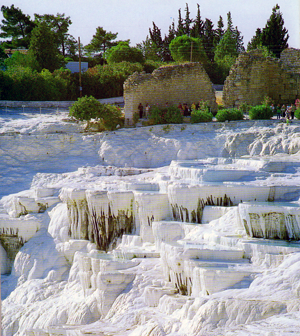 New Zealand although some spectacular ones were demolished in an earth quake many years ago.
New Zealand although some spectacular ones were demolished in an earth quake many years ago.
 New Zealand although some spectacular ones were demolished in an earth quake many years ago.
New Zealand although some spectacular ones were demolished in an earth quake many years ago.Now known as Pamukkale, the city of Hierapolis suffered numerous earthquakes during ancient Roman times. The highly prized mineral springs ensured that the city was restored and continued as a major spa during the times of Hadrianus and Caracalla. The mineral deposits result from the spring waters containing high levels of potassium, sodium, calcium and magnesium chlorides and sulphates. Now the resort is a popular tourism destination. Visitors can explore the hillside pools and the Roman ruins. There are also bathing facilities for those who wish to enjoy the spa waters. Malvern waters, by contrast, are very pure and so no matter how hard we try, we could not enjoy the same natural facilities as Hierapolis in one of the disused quarries on the Malvern Hills.
For more information read Pamukkale by Tevhit Kekec (Istanbul 1992)
Malvern Grotto upstaged by Mitcham
A Friend has contacted us with an interesting story. This follows the article in the last Newsletter about the recent destruction of the Gothic Well, which is thought to have been originally built as a grotto. The Friend recalls living in Mitcham, South London as a child and, much to the embarrassment of her father at the time, tells how she and her friends funded their school summer holiday fun. 'Penny for the grotto' (more often pronounced grotta in local parlance) was how Mitcham children attempted to raise money to spend at the local fair held on Fair Green annually in August.
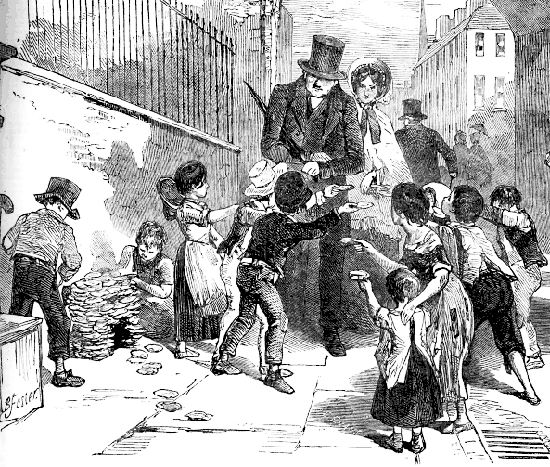
The structures the children produced at kerb sides were made of earth, shells, tawdry odds and ends of ribbons, bits of mirror or scraps of silver paper to represent water, and flowers 'borrowed' from local gardens. Perhaps some went so far as to scoop out a cave but this was by no means essential. Grottos were often constructed on old trays so that they could be transported to more lucrative sites or moved swiftly out of sight of disapproving parents or adults likely to snitch. Passers-by were asked to give 'a penny for the grotto'. The more elaborate and decorative, the more it was likely to attract pennies. It is probable that most of the children constructing grottoes had no idea of the 18th century Italianate background to grottoes as part of a fashionable landscaped garden of the gentry. The tradition appears to have died out in the 1950s for the local kids but originally was believed not just confined to Mitcham.
Peace after war is when you realise nobody wins - even with Well Decorating?
Most of the world will remember 2014 as the centenary of the start of the First World War - the war to end all wars. So the theme for this year's May Day well-decorating is Peace, when we try to understand and commiserate with the death and destruction of so many, thus ensuring it stays in our collective memory. The ancient Greeks apparently had their own way - by building battle monuments out of wood. The wood slowly decayed and reverted to nature. This enabled the populace to forget the exceedingly traumatic and unpleasant events of war and concentrate on pleasant things in the future. During the First World War countless people were killed and resources were diverted to armaments and death, rather than to improving the lives of the living. Official homicide became a celebrated achievement rather than shameful, premature extinguishing of someone's life. Let's hope the interpretation of the theme for Malvern's well decorating can reflect the immorality of war rather than celebrate it.
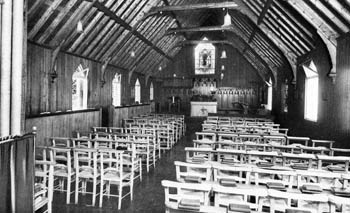
Cora Discovers Background to Wells House Chapel
In our last Newsletter we featured the restoration of the Wells House Chapel. Spotted by chance, we learn that the following appeared in the Malvern Advertiser 23 July 1904.
The Wells House's new school chapel stands on the hillside north-west of Wells House. It is made of corrugated iron on a brick foundation. The chapel is 40-feet long, 20-feet wide; the height to the eaves on the inside is 9-feet and outside 10-feet. The height to the ridge of the high-pitched roof is 22-feet. The inner walls are of 4" wide red Oregon pine boards and there is a 4-inch air space between this inner wall and the exterior iron wall. The chapel is ventilated by two of Boyle's patent ventilators. Lighting is through two seven-light gas coronas and several side windows. There is a large window in the north gable and a smaller one in the south gable, both with multi-coloured "Cathedral" glass. There is a small, 6-foot square porch with a tiled floor. Schoolboys - members of the carpentry class - have helped to build the chapel and will install the seating. The chapel and its furniture have been paid for by people interested in the school. For example, the brass cross above the communion table was the gift of two old boys and the lectern was the gift of Rev. W. Gedge who founded the school in 1870.
The picture - courtesy Malvern Museum, shows chairs in the chapel whereas the one on our website Discovery Trail Site 74 (www.malvernspringsandwells.com) shows pews - which came first, we assume the boys made the pews?
Heritage Listing initiative at last
Friends will be pleased to learn that Malvern Hills District Council is working with local groups to form a Heritage List of Local History Assets. We are anticipating that this will include many of our springs and wells structures after the recent loss of the Gothic Well Grotto and access to the Myrtles Spring and Grindrod's Fountain. Cora compiled and deposited a list of structures with the Civic Society some five years ago for this purpose and it is hoped that this will provide the starting point. Our web site www.malvernspringsandwells.com provides an up-to-date information source on Malvern's springs and wells to update the earlier list. A draft Supplementary Planning Document setting out procedures for identifying assets is now currently undergoing wider consultation.
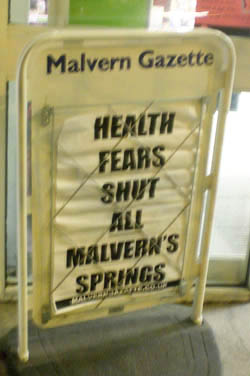 Malvern Springs Suffer a Public Relations Blow
Malvern Springs Suffer a Public Relations BlowOn 28 February the Malvern Gazette published a front page headline "Contamination shuts all Malvern's springs". We learn that twelve springs have been posted with notices by Worcestershire Regulatory Services indicating that they had failed recent bacteriological tests. This information went viral, adding to the sensationalism that the announcement generated.
Contamination is a common problem with surface springs and is usually caused by rain washing in detritus from the surrounding land into the water. This applies particularly after a long dry spell, when debris has collected and the rain does not readily soak into the subsoil. It also applies when there is excessive rainfall that causes unusually large volumes of water to flow over the surface, picking up contaminants and washing into the spring water. This is likely the cause this winter.
What is the effect of such publicity a Friend has asked? On the downside, tourism in the Malvern Hills will take a knock as the name Malvern becomes associated with contaminated water. This will have a detrimental effect on the local economy. On the positive side the announcement informs the public that they need to boil the water before using it for drinking purposes. Perhaps what needs further consideration is how such announcements are managed. Do we need to project a clearer indication generally to the public that spring waters are naturally occurring resources and, like streams and rivers, do suffer the machinations of nature? Or do we enforce a shut-down while the contamination is present? It is very much like the Gullet Quarry debate, deny access or educate those contemplating leaping into the waters. We welcome your views.
Email: springs@thespas.co.uk (click here to send an email)
Website: Click Here
SUPPLEMENTARY INFORMATION
The home page can be accessed by clicking website above.
Contact Information:
Friends main website - www.MalvernWaters.com
 Newsletter Archive which can also be accessed from our WEB SITE INDEX.
Newsletter Archive which can also be accessed from our WEB SITE INDEX.
Friendship - There is no charge made for joining Friends of Malvern Springs and Wells. Just let us have your email address and we will send our newsletters, which are usually two monthly. Please be aware that some email addresses block large circulation emails. Do feel free to participate in our activities by contacting us below.

Best wishes, Cora & Bruce
Bruce Osborne, Tower House, Tadworth, Surrey. KT20 5QY
Tel. 01737 213169 email bruce@thespas.co.uk
Tel. 01737 213169 email bruce@thespas.co.uk
Cora Weaver, 4 Hall Green, Malvern, Worcs. WR14 3QX
Tel. 01684 561215 email cora@malvernspa.com
Tel. 01684 561215 email cora@malvernspa.com
1) TOPOGRAPHICAL LOCATION:
Malvern Hills - arguably Britain's original National Park
3) INFORMATION CATEGORY:
History & HeritageFriends Newsletter


